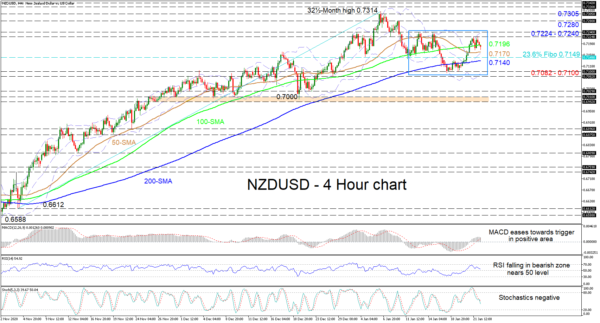NZDUSD’s slide back under the 100-period simple moving average (SMA) at 0.7196 seems to have cemented the price within the confines of 0.7082-0.7240, of a sideways move. The range bound demeanour, after the price retracted from the multi-year high of 0.7314, looks to be nourished by the impaired and flattening 50-period SMA and the slowing upward pace of the 100- and 200-period SMAs.
A glance at the short-term oscillators shows they are nurturing bearish scenarios. The MACD, above the zero mark, is easing towards its red trigger line, while the declining RSI is approaching the 50 threshold. Furthermore, the negatively charged stochastic oscillator is promoting additional fading in price.
If the pair continues to dwindle, immediate downside hindrance could develop around the 50-period SMA at 0.7170, where the mid-Bollinger band also resides, ahead of the 0.7149 barrier. Pushing under the latter, which happens to be the 23.6% Fibonacci retracement of the up leg from 0.6612 until 0.7314, the neighbouring 200-period SMA at 0.7140 could attempt to dismiss further declines in price. Should sellers remain in control, they may challenge the foundation of the range of 0.7082-0.7100, which also contains the lower Bollinger band.
If buyers manage to step back above the 100-period SMA at 0.7196, hovering overhead is the resistance ceiling of 0.7224-0.7240, of the horizontal pattern, which may impede additional gains. However, should the bulls triumph over this frontier, the price may shoot for the 0.7280 border before targeting the 0.7305 high, around the 32½-month peak.
Summarizing, NZDUSD retains a fairly neutral-to-bullish tone above the 0.7082-0.7100 boundary. The oscillating price would need to break below 0.7082-0.7100 or above 0.7224-0.7240 for a clearer direction to unfold.













